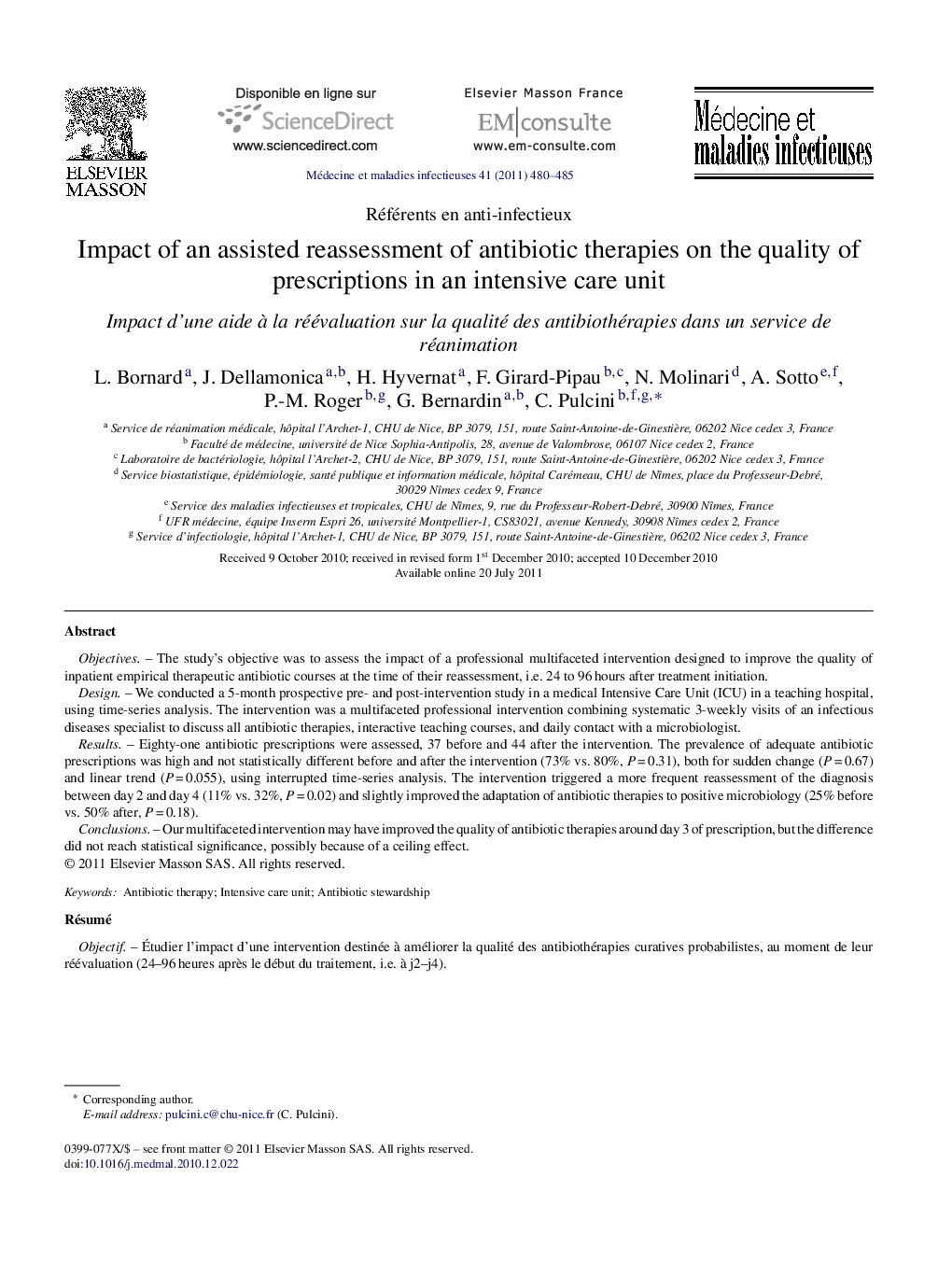| Article ID | Journal | Published Year | Pages | File Type |
|---|---|---|---|---|
| 3413175 | Médecine et Maladies Infectieuses | 2011 | 6 Pages |
ObjectivesThe study's objective was to assess the impact of a professional multifaceted intervention designed to improve the quality of inpatient empirical therapeutic antibiotic courses at the time of their reassessment, i.e. 24 to 96 hours after treatment initiation.DesignWe conducted a 5-month prospective pre- and post-intervention study in a medical Intensive Care Unit (ICU) in a teaching hospital, using time-series analysis. The intervention was a multifaceted professional intervention combining systematic 3-weekly visits of an infectious diseases specialist to discuss all antibiotic therapies, interactive teaching courses, and daily contact with a microbiologist.ResultsEighty-one antibiotic prescriptions were assessed, 37 before and 44 after the intervention. The prevalence of adequate antibiotic prescriptions was high and not statistically different before and after the intervention (73% vs. 80%, P = 0.31), both for sudden change (P = 0.67) and linear trend (P = 0.055), using interrupted time-series analysis. The intervention triggered a more frequent reassessment of the diagnosis between day 2 and day 4 (11% vs. 32%, P = 0.02) and slightly improved the adaptation of antibiotic therapies to positive microbiology (25% before vs. 50% after, P = 0.18).ConclusionsOur multifaceted intervention may have improved the quality of antibiotic therapies around day 3 of prescription, but the difference did not reach statistical significance, possibly because of a ceiling effect.
RésuméObjectifÉtudier l’impact d’une intervention destinée à améliorer la qualité des antibiothérapies curatives probabilistes, au moment de leur réévaluation (24–96 heures après le début du traitement, i.e. à j2–j4).Patients et méthodesÉtude prospective interventionnelle de type avant/après menée durant une période de cinq mois dans un service de réanimation médicale de CHU, avec une analyse par séries chronologiques. L’intervention associait le passage systématique trois fois/semaine d’un infectiologue pour discuter de toutes les antibiothérapies, des sessions de formation interactives et une rencontre quotidienne avec un bactériologiste.RésultatsQuatre-vingt et un antibiothérapies ont été évaluées, 37 avant et 44 après l’intervention. La proportion d’antibiothérapies adaptées était élevée, sans différence significative entre les deux périodes (73% avant vs 80% après l’intervention, p = 0,31), que ce soit pour le changement de niveau (p = 0,67) ou de gradient de la pente (p = 0,055) en analyse par séries chronologiques. La réévaluation du diagnostic était plus souvent réalisée à j2–j4 après l’intervention (11% vs 32%, p = 0,02), et les antibiothérapies étaient plus souvent adaptées à un résultat microbiologique positif, sans que la différence soit statistiquement significative (25% vs 50%, p = 0,18).ConclusionsNotre intervention menée à plusieurs niveaux semble avoir amélioré la qualité de l’antibiothérapie à j2–j4, mais pas de manière statistiquement significative, possiblement du fait d’un effet plafond.
